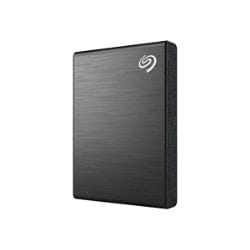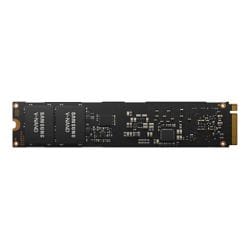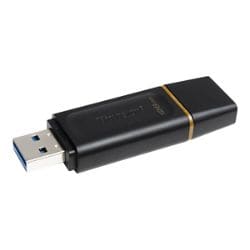September 19, 2022
Computer History: A Timeline of Storage and Memory
Since the late 1920s, computer memory and storage technology continue to allow more storage with less space. The history of storage and memory devices includes magnetic, optical and solid state drives.
Humans have been using technology to store data for decades, and advancements in technology since the late 1920s continue to allow more storage with less space. Magnetic tapes, hard disks, floppy disks, CDs, flash drives, USB drives, SD cards and HD-DVDs are types of devices that record and store information in bytes. Some common storage capacities include kilobytes, megabytes and gigabytes. The history of storage and memory devices includes three main forms: magnetic, optical and solid state.
- 1928: Magnetic Tape: Fritz Pfleumer develops the magnetic tape method for storing information. Pfleumer bases the creation of the device on magnetic wire recording. The tape is made up of a magnetic coating that can record both audio and video.
- IBM was one of the first companies to implement magnetic tape storage methods in its computers.
- 1932: Magnetic Drum: Gustav Tauschek took the concept of magnetic tape further with the invention of the magnetic drum. A ferromagnetic strip exists on the outside of the drum, which has read and write capabilities. The drum records data by rotating and using pulses of electricity.
- Until the invention of core memory, magnetic drums served as a form of computer memory through the 1960s.
- 1946: Williams Tube: The Williams tube is the first known type of random access memory (RAM). Created in the United Kingdom by Freddie Williams, the Williams tube uses electrostatic cathode-ray display tubes. The tube's early storage capacities ranged from 1024 to 2048 bits.
- The tube came about due to an investigation into ways to store both analog and digital information.
- 1946: Selectron Tube: Also developed in 1946, the Selectron tube owes its origins to the Radio Corporation of America (RCA). It was first planned as one of the IT solutions for John von Neumann's IAS machine, but RCA had to decrease production of the Selectron tube due to manufacturing difficulties.
- The Selectron tube is smaller, more reliable and more efficient than the Williams tube, but it costs too much to effectively penetrate the market.
- 1949: Delay Line Memory: Delay line memory involves inputting information sequences into a delayed path. Amplified and timed circuits connect the beginning and end of the path, allowing the information sequences to move back and forth in a circle.
- Upon its first practical use, Delay line memory could store 512 35-bit words.
- 1949: Magnetic Core: Tiny magnetic ceramic rings or cores make up magnetic core memory. An Wang invented the method in 1949 by controlling how the electrical current switched within the cores' magnetic field.
- Due to its low cost, this type of memory overtook the market in the early 1960s, pushing drum and tube forms aside.
- 1956: Hard Disk: A central axis and rotating platters make up a hard disk. The disk records and relays information on magnetic material. A hard disk consists of moving parts, including both read and write heads.
- The IBM 305 computer launched the hard disk standard for storage and memory in 1956.
- 1963: Music Tape: Philips brought the music tape to the market in 1963. With the introduction of portable compact cassette players in 1979, the music tape became a widely popular way of listening to recorded audio files.
- Personal computers used the cassette format into the early 1980s due to its cost advantages over floppy disks.
- 1966: DRAM: Dynamic Random Access Memory (DRAM) stores information in the form of an electrical charge within a circuit. Robert H. Dennard invented DRAM in 1966, increasing the amount of memory stored within limited space.
- DRAM is a form of random access memory.
- 1968: Twister Memory: Magnetic tape wrapped around a wire carrying electrical current is known as twister memory.
- Bell Labs created this memory form in 1968, but it did not survive long in the marketplace. RAM chips replaced twister memory by the mid-1970s.
- 1970: Bubble Memory: Magnetic material holds miniature magnetized areas that store one bit of information. These magnetized areas form a circle of bubbles that rotate past a read/write head.
- The main drawback to bubble memory is its slow speed.
- 1971: 8-Inch Floppy: Floppy disks are made of magnetic material covered by plastic in the shape of a square or rectangle. These disks must be read by floppy disk drives.
- IBM first used floppy disks to load code into mainframe systems.
1971
IBM first used floppy disks to load code into mainframe systems.
- 1976: 5.25-Inch Floppy: Alan Shugart created the 5.25-inch floppy disk for desktop computers. The initial storage limit was 110 kilobytes.
- In 1978, the storage capacity of the 5.25-inch floppy disk increased to 360 kilobytes.
- 1980: CD: The compact disc (CD) is an optical form of media storage, first created for holding digital audio files.
- A 120 mm CD can store 74 minutes of audio.
- 1981: 3.5-Inch Floppy: The 3.5-inch floppy is square in shape and has a metal cover that slides to the side once the disk is put into a floppy drive. The metal cover protects the data from becoming damaged.
- Storage capacities for the 3.5-inch disk range from 360 kilobytes to 1,440 kilobytes.
- 1984: CD-ROM: Compact Disc Read-Only Memory (CD-ROM) allows the storage of microscopic digital data. A CD-ROM is an optical form of storage.
- Sony and Philips created the standard for the CD-ROM in 1985.
- 1987: DAT: The Digital Audio Tape (DAT) records and plays digital audio files. DAT comes in cassette form but is approximately half the size of a music tape.
- The DAT's rotating head and helical scan prevents physical editing of the cassette's data.
- 1989: DDS: Digital Data Storage (DDS) is a magnetic form of storing data. The technology emerged from DAT.
- DDS tapes in the original DDS format will play in both DAT and DDS machines.
- 1990: MOD: The Magneto-Optical Disc (MOD) uses both magnetic and optical methods. A MOD disc can be 3.5 inches or 5.25 inches in size.
- Originally, the MOD disc needed to erase, write and then verify the data during the writing process. The invention of direct overwrite technology got rid of the erasing portion of the process in order to increase speed.
- 1992: MiniDisc: Sony brought the MiniDisc to market in 1992 to replace analog cassette tapes. The MiniDisc can store multiple forms of data and contains a sliding door similar to the 3.5-inch floppy.
- A MiniDisc comes in recordable and premastered forms.
- 1993: DLT: The Digital Equipment Corporation invents the Digital Linear Tape (DLT) standard for computer data storage.
- Quantum Corporation purchased DLT technology in 1994 and is the current manufacturer and licensor.
- 1994: Compact Flash: A Compact Flash card is a solid state device that uses flash memory. These devices consume either 3 or 5 volts of power.
- A Compact Flash drive is less susceptible to data corruption than disk drives because there are not any moving parts.
- 1994: Zip: Introduced toward the end of 1994, a Zip disk has several advantages over the floppy media. A Zip drive can transfer data at a higher speed and hold more data.
- A Zip disk could initially store up to 100 megabytes of data.
- 1995: DVD: The DVD is a form of optical disc storage. It is designed to hold more data and more types of data and be faster than CD or CD-ROM technologies.
- As of 2003, more than 250 million forms of DVD playback devices were in use.
- 1995: SmartMedia: Toshiba introduced SmartMedia in 1995 as a flash memory card standard. SmartMedia cards were created for portable devices such as digital cameras.
- Some laptops and desktops have SmartMedia slots.
- 1995: Phasewriter Dual: Phasewriter Dual (PD) technology is an optical storage device standard that Panasonic introduced in 1995.
- As of 2001, Phasewriter Dual technology is no longer on the market.
- 1996: AIT: Sony developed the Advanced Intelligent Tape (AIT) in 1996 based on the DAT format.
- AIT is a backup system and has four times the capacity of DAT.
- 1996: CD-RW: Compact Disc Rewritable (CD-RW) technology allows users to re-write data to a CD-ROM. A CD-RW has an aluminum reflecting layer and a phase-change recording layer.
- The typical CD-RW drive can write approximately 700MB of information to a CD-RW disc.
1996
Compact Disc Rewritable (CD-RW) technology allows users to re-write data to a CD-ROM.
- 1997: Multimedia Card: Siemens and SanDisk develop the Multimedia Card (MMC) as a standard for flash memory. A Multimedia Card is approximately the same size as a postage stamp and is typically used in portable devices.
- Depending upon its size, a Multimedia Card can store up to 2 GB of data.
- 1998: Memory Stick: In October of 1998, Sony introduced the Memory Stick, which is a removable memory card format. Users can store data on a Memory Stick from one computer and then remove the stick to access the same data on a different computer.
- Initial sizes of the Memory Stick ranged from 4 megabytes to 128 megabytes.
- 1999: Microdrive: Microdrives are 1 inch in diameter and use magnetic memory. IBM developed the technology as an alternative to other available IT solutions in 1999, with an initial capacity of 340 megabytes.
- All microdrives are susceptible to damage from low air pressure and vibrations.
- 2001: USB Key: A USB key operates with flash memory and is hot-swappable between computers. The USB device receives its power from the computer and is also known as a flash drive or a thumb drive.
- A USB key plugs into a computer's USB port or a connected USB hub.
- 2001: SD Card: Secure Digital (SD) cards use flash memory. Although SD cards are based on the MMC format, DRM encryption is added to increase transfer speeds.
- An SD card can be used in PDAs, some cell phones, and some portable game consoles.
- 2003: Blu-Ray: Blu-ray technology would go on to compete with the HD-DVD format. The Blu-ray format is an optical disc for high-definition video and the storage of high-density data.
- A single-layer Blu-ray disc can store more than two hours of high-definition video.
- 2003: xD-Picture Card: An xD-Picture Card can be used in Olympus or Fujifilm digital cameras. The cards are made in the flash memory format and can store between 16 megabytes and 1 gigabyte of data.
- The xD-Picture Card is compact but costs more than the competition.
- 2004: WMV-HD: Windows Media High Definition Video (WMV-HD) codes high-definition video with Microsoft Windows Media Video 9 codecs. A codec is either a device or an application that compresses data so that it can be transferred more efficiently.
- Professional desktop video editing in certain Windows operating systems is possible with WMV-HD.
- 2004: HD-DVD: HD-DVD is one of the optical disc standards for high-definition video.
- The storage capacity of an HD-DVD is 15 gigabytes for a single-layer disc and 30 gigabytes for a dual-layer disc.
2004
HD-DVD grows storage capacity to 15 gigabytes for a single-layer disc and 30 gigabytes for a dual-layer disc.
- 2004: Holographic Memory: Using the holographic method, users can store data at high density levels in crystals or photopolymers. Although the holographic method has not become popular yet, it has potential since it can surpass the limits of DVD technology.
- Users record data onto holographic media using the entire volume instead of only the media's surface.




